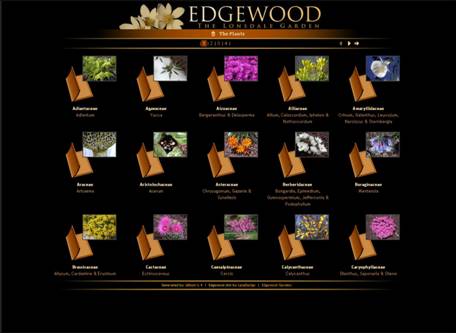Synopsis: John will discuss the methods he uses to cultivate and propagate Trilliums in his USDA zone 6b garden in SE Pennsylvania. He will describe the siting and natural and artificial methods used to successfully grow most of the Trillium species found in the eastern USA, from the early-rising sessile species found below the Fall Line in the Deep South to the pedicellate species that favor the cooler, higher habitats of the eastern mountains. While trilliums are a major garden feature from late March to late June, they are complemented by a wide variety of plants. The presentation will highlight choice companion plants such as Hepatica, Erythronium, Cypripedium, Epimedium, Cyclamen, Asarum, Anemonella, Arisaema and Phlox, and include details about their cultivation and propagation.
Presentation: In the first half of his presentation, John described his Exton garden and various aspects of the cultivation and propagation of trilliums that he grows. In the second half he described some of the many plants that make excellent companions for Trilliums in the woodland garden.

“Edgewood Gardens” comprises approximately 1.7 acres of mainly open deciduous woodland in SE Pennsylvania in USDA zone 6b at an elevation of 610’. The soil is slightly acid, pH 6-6.5, and the garden is perfectly drained, particularly across the large slope that bisects the property. A 8’ tall deer fence encloses entire garden, without which it would be impossible to grow the majority of the plants described. The soil is unamended except for the annual addition of a mulch of shredded leaves which are collected on the property. The garden is not artificially fertilized and supplementary water is only given in summer if necessary using a network of sprinklers.
It is frequently stated that when considering how best to grow plants one should endeavor to match their native habitat when choosing a site for them. This is certainly sound advice and important if you want strong natural regeneration from seed; however it is not generally necessary for mature plants if their basic needs are met. For example, Trillium pusillum var. alabamicum grows in nature in low woodlands which are vernally very wet, but fares very well on a steep slope in the garden. There are exceptions, of course: T. undulatumneeds significant diurnal temperature variation to succeed, in addition to its other requirements, and the Western sessile trillium species struggle on the eastern Piedmont and coastal plain because they dislike hot & humid summers. Soil pH is similarly not critical to the successful cultivation of many trilliums. Acid soil (pH 6.5) causes no apparent injury or nutrient deficiency to any trilliums but experience has shown that trilliums from alkaline habitats seem more susceptible to rhizome rot than those growing on acid or neutral substrates. T. maculatum & T. nivale from habitats with an alkaline pH are particularly prone to rot in acid soils. An alkaline pH is known to inhibit the root pathogenic Pythium & Phytophthora fungi, but plants from alkaline habitats are weakly or not adapted to resist infection and may succumb in the heat and humidity encountered in the summer which favors fungal growth.
Cold ‘hardiness’ is obviously a major consideration when attempting to grow plants from regions other than your own. All trillium rhizomes are cold hardy in this zone 6b garden; however the early emergence of ‘southern’ forms, especially of T. decipiens & T. underwoodii can be an issue. In habitat in the Florida Panhandle and SW Georgia these species have negligible vernalization needs – by the turn of the year they have experienced all the ‘winter’ they need and by January they are up and running, flowering in mid-February. This pattern of growth isn’t conducive to survival in the open garden in northern gardens because winter is far from over when the plants programming tells them it is time to emerge. Interestingly, the leaves tolerate severe cold as long as the ground is not frozen; frozen ground in combination with direct sun and/or wind causes complete desiccation & loss of leaves & stems because the plants are unable to transpire. There does seem to be considerable intra-specific variability in susceptibility of leaves to freezing in T. decipiens and this may indicate potential for breeding forms more resistant to damage T. foetidissimum & T. ludovicianum also flower early in habitat, at the end of February and in early March, but seem better able to adjust to a northern winter by delaying their emergence more.
‘Northern’ forms of T. decipiens & T. underwoodii from east-central Alabama emerge much later and make excellent garden plants.
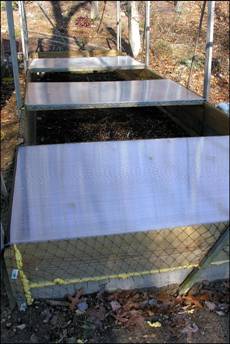
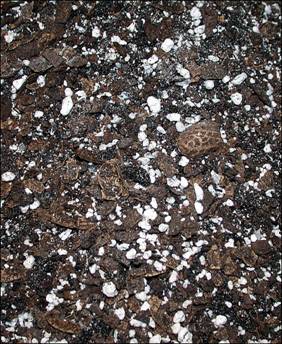
A cold frame is used to allow these freeze-desiccation susceptible trilliums to flower and carry seed to maturity and is also suitable for direct sowing of seeds of vulnerable species. Twin-wall polycarbonate hinged covers are used in combination with a soil warming cable, electric or Parasene’ heater and the temperature maintained at a level to just stop soil freezing after foliage emergence. Good air flow is needed to avoid fungal diseases.
The soil used in cold frames and pots is a mixture of BioComp BC5 (composted peanut shells and pine bark) & supercoarse perlite; this gives excellent air-filled porosity & moisture retention & perfect drainage, allowing plants to form very strong root systems.

The pollination of trilliums is a bit of a mystery; however small ‘gnats’ can be seen on many species, both sessile and pedicillate, in late April. It is possible that there may be a common attractant produced by trilliums to encourage these potential pollinators. However, seed is still set in the absence of these flies. Seed is collected approximately one week before capsules open naturally, when the seeds are a light honey brown color. Seeds of all sessile trilliums are collected at the same time; seeds from pedicillate trilliums ripen 2-4 weeks later, with the exceptions of T. nivale & T. grandiflorum which ripen even before the sessiles and can easily be forgotten! Intact seed capsules are placed into Zip-loc bags and refrigerated or kept at room temperature until the capsules have disintegrated. It is important not to overdo it because there is a fine line between facilitating cleaning & allowing seeds to rot. Seeds are cleaned of debris under running water and soaked in ZeroTol sterilant, dried & refrigerated without desiccating. They should ideally be sown as soon as possible, either directly into the ground around mature plants or in seedling beds containing the same compost described above. Seeds are sown in rows & covered with 1 cm of compost; cotyledon emergence is usually the second spring after sowing, after which seedlings are fed regularly with weak fertilizer until they are potted up or planted out when large enough, usually after 3-4 years.
As discussed by several speakers, trilliums can also be propagated vegetatively by beheading rhizomes in summer after flowering. The ‘front’ end with bud and current year’s roots and ‘back’ end are replanted in situ and the latter, deprived of apical dominance, will generate many offsets.
Many of the Deep South sessile trillium species are as valuable in the garden for their stunning leaf markings as they are for their flowers. T. underwoodii, in particular, shows a wide range of spectacular forms which maintain their markings the whole time the plant is above ground. Two examples are shown below.
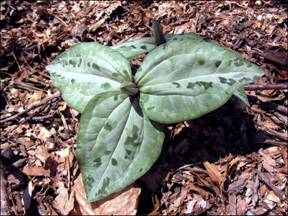

T. cuneatum also has leaves with a wonderful variety of markings, although these tend to fade fairly rapidly after the leaves have matured. This species also shows the greatest variation of flower color of any of the eastern sessile species.
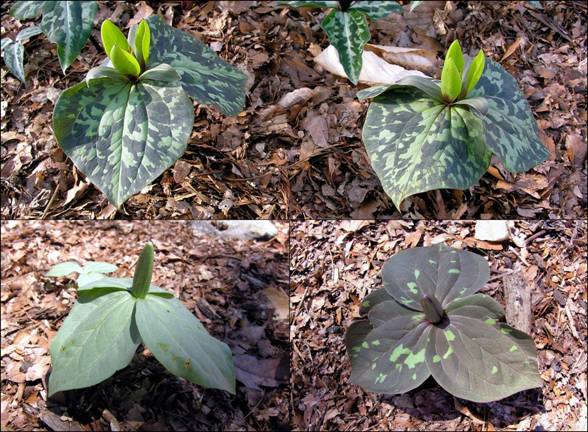
T. recurvatum has less remarkable leaf markings, although forms with all-over silver leaves are known. However, there is a lot of variation in flower color, from the deep maroon of the type to the yellow of forma shayi; most attractive is a form with peach colored flowers which hold their color for several weeks, fading eventually to a straw color.
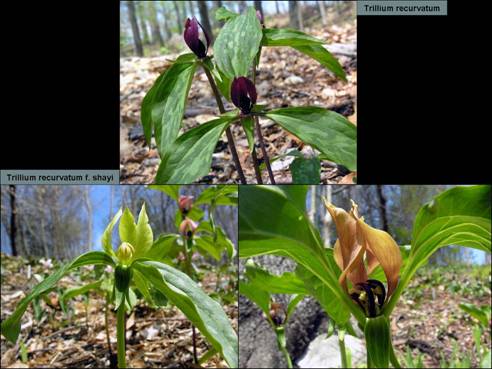
The second part of the presentation focused on a variety of plants which grow well in similar garden situations to those favored by trilliums. Many of the plants that flower in earliest spring in the garden are members of the Ranunculaceae (Buttercup) family. Adonis amurensis is a very hardy Japanese woodlander that has long been in cultivation in its yellow form but which recently reached the USA in several ‘new’ forms including those with amazing burnt orange flowers.
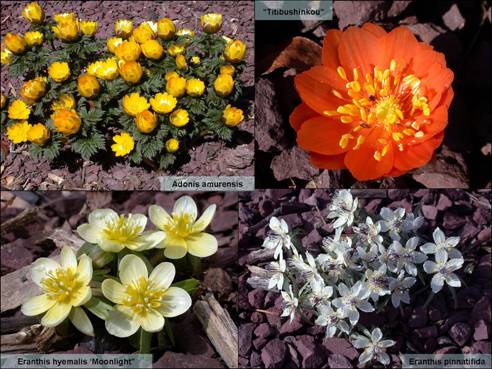
It is easy to cultivate in typical woodland conditions, flowering in March, even through snow and ice! The ferny leaves are only above ground until late May and propagation is by division in early spring or fall. Two winter aconites were also shown, flowering at a similar time. E. hyemalis ‘Moonlight’ is a beautiful pale yellow form of the common species that comes true from seed and E. pinnatifida is another Japanese plant that has beautiful white flowers and blue-green attractively cut foliage. Seedlings can be difficult to get through their first dormancy and will flower in 4 years.
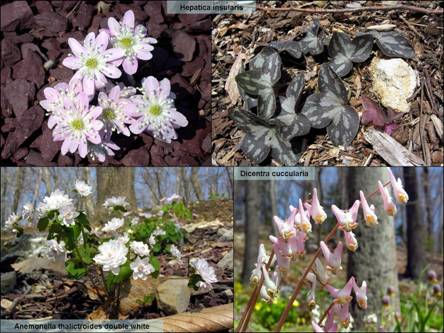
All species of hepatica are wonderful plants for the woodland garden. Hepatica insularis from Korea is especially valuable because it has very attractive shell pink or white flowers but also has wonderfully marked leaves which retain their pattern through much of the season. It is deciduous and very hardy; propagation is easy by seed although care has to be exercised to catch the still green seed when it is ripe in late May or early June. Anemonella thalictroides is a spring ephemeral that is widely grown in its pink and white phases, but keep an eye open for the half dozen or so double forms which include the double white shown above. Another commonly grown and usually white-flowered eastern USA native is Dicentra cuccularia. The form shown, however, is a good pink with a biscuit colored nose, a form occasionally encountered in the wild. Bulbous corydalis, unlike the fleshy-rooted Chinese species like Corydalis flexuosa, make excellent garden plants. They flower in earliest spring, increase well by division but also seed around copiously, although they are never a weed. Many color forms are now available commercially and if you select 6 or so different ones and let them seed around you will soon enough have all the others, just without the labels! C. solida ‘Firecracker’ is beautiful red form that was shown together with the white C. malkensis, which makes large clumps and seeds freely. Two forms of Sanguinaria canadensis were shown, ‘Betty Casto’ and a pink flowered selection. ‘Betty Casto’ is a double that originated in West Virginia which has unusual semi double starry flowers, the pink form has a good pink reverse to the flower but the inside of the petals is white. It is important to divide all forms of bloodroot on a regular basis because large clumps can rot without warning leaving little if anything behind. They seed around the garden freely, but germination in pots, even of fresh seed, is very poor.
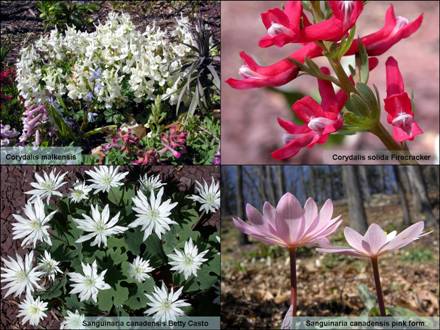
Members of the Berberidaceae family, and Epimediums in particular, have become very popular in recent years; the range of species and selections has increased exponentially, in large part due to the efforts of Darrel Probst. Like many woodlanders, if given plenty of moisture during their period of most active growth in the spring, they will be happy in considerably more sun than generally accepted. This increases both flower power and the intensity of the leaf coloration. Two favorites were shown, E. brachyrrhizum ‘Karen’ and E. lishihchenii, the former with raspberry red new foliage, the latter with tangerine colored new leaves, fading to lime green. Dysosma veitchii (syn. delavayi) is an example of the new Chinese introductions in recent years, having incredibly marked new foliage, like a bizarre starfish, and red flowers. Increase is from seed, although new plants have been formed from adventitious root buds.
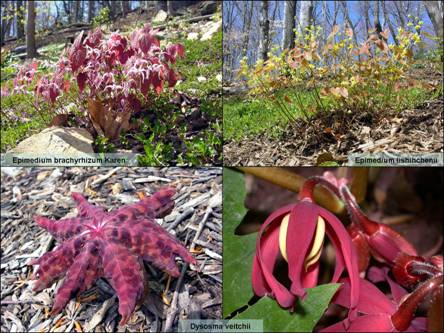
The Erythroniums, or trout lilies, are firm favorites in the Liliaceae family, hailing from Europe and Asia as well as both sides of the USA. They are true bulbs, often shaped like dog’s teeth, hence their other common name of ‘dog’s tooth violets, which usually are found at significant depth in the soil. They reproduced both by division and seed; seedlings can take 5 or more years to reach flowering size. Erythronium caucasicum is, unsurprisingly, from the Caucasus mountains and is one the first plants in flower each spring, with pure white flowers and beautifully marked leaves. Erythronium hendersonii is one of the western USA species which does very well in eastern gardens, unlike many of the mountain species from the west. Erythronium americanum flowers well in this garden, although apparently less reliably elsewhere; perhaps the conditions here, which are less favorable for the massive vegetative reproduction seen on flood plains, encourage better flowering and therefore opportunities for spread via seed. Erythronium rostratum is the best of all and is hardy despite its origins in Louisiana. The flowers, which are reliably borne, can easily be 4’ across, are held upwards facing the sun, which they track across the sky. Further bonuses are a wonderful scent and moderate increase by stolons.
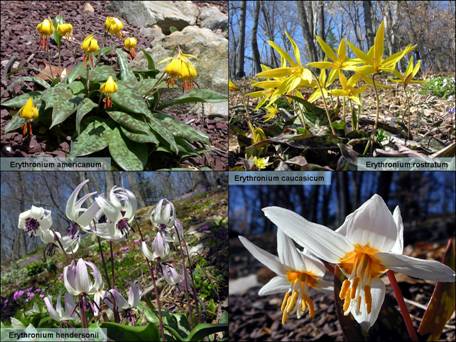
Arisaemas and Asarums have also become in vogue in recent years and the ever popular A. sikokianum was shown. Provided with perfect drainage it is not especially long-lived but is easily raised from seed. A Chinese species of Asarum was presented, identity unknown, which has beautiful leaves covered with short hairs which give an appearance of velvet or a metallic sheen, depending upon the incidence of the light. No woodland garden is complete without slipper orchids and the eastern yellow ladies slippers have proved to be easy of culture here, with clumps increasing in size very satisfactorily. Propagation is best by division every 3-4 years in late summer or early fall, reducing large clumps down to groups with 2-4 noses. Fortunately the most spectacular, Cypripedium kentuckiense, is also the easiest to grow, thriving in many places in the garden in numerous slightly variable forms; petal color varying from ivory to deep yellow, and sepal color from mahogany to almost green. Orchids are also valuable for their foliage in winter – particularly the metallic purple-leaved postulate form of Tipularia discolor, the crane fly orchid, which was presented. Although the summer flowers are not particularly showy, a large clump of leaves makes a nice show in the winter garden. It spreads slowly, making a chain of tubers.
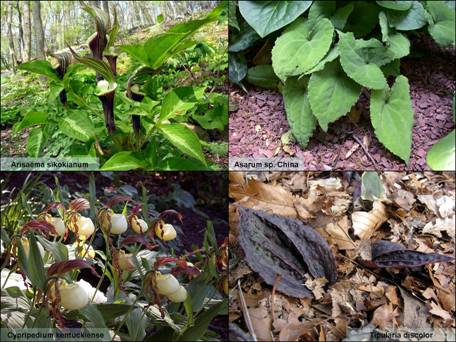
The early summer garden would not be complete without the amazing flowers of the Indian Pink, Spigelia marilandica, which looks far too exotic to grace its native haunts, principally in the southern states. Easy of culture in average conditions, although quite late to appear, it is easy to propagate both by seed and division.
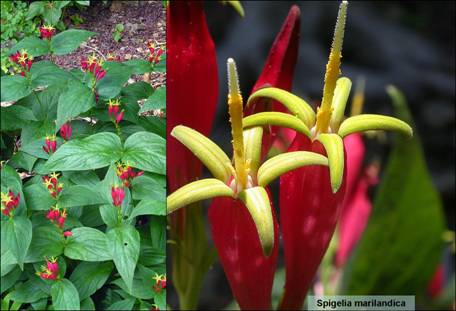
The early summer garden would not be complete without the amazing flowers of the Indian Pink, Spigelia marilandica, which looks far too exotic to grace its native haunts, principally in the southern states. Easy of culture in average conditions, although quite late to appear, it is easy to propagate both by seed and division.

The images presented, together with over 5000 others of plants grown at ‘Edgewood Gardens’, can be found on John Lonsdale’s website – www.edgewoodgardens.net – in addition to a number of articles describing the many woodland and other plants cultivated and propagated.
